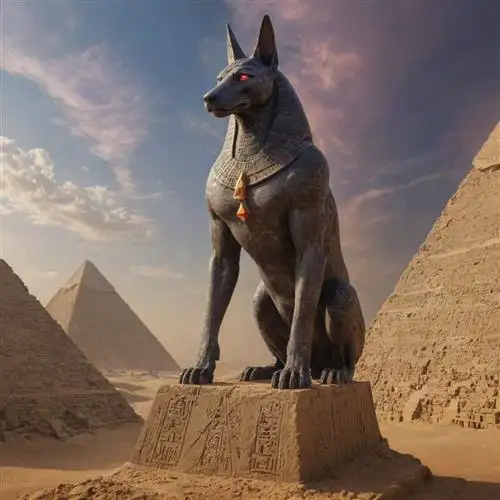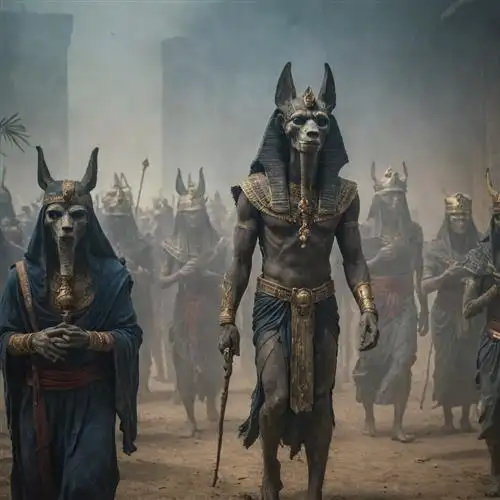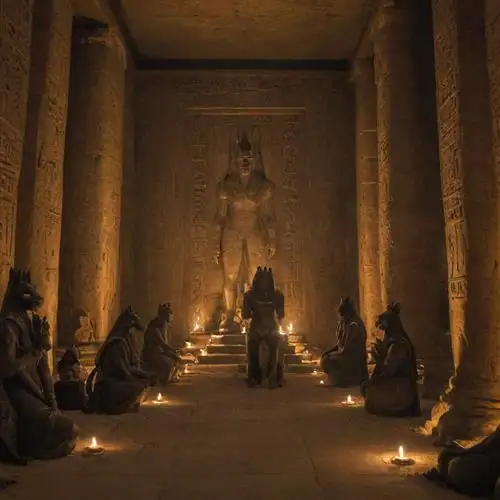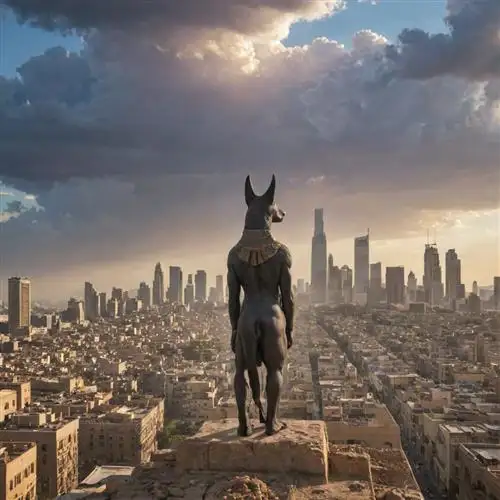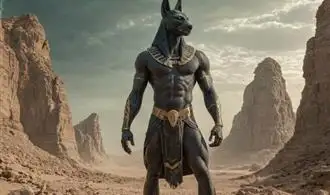
The Origins of Anubis
Anubis, the enigmatic Egyptian god, has long been a subject of fascination and scholarly inquiry. As the jackal-headed deity associated with mummification, the afterlife, and the protection of the dead, Anubis holds a central role in the rich tapestry of ancient Egyptian mythology. Tracing the origins of this mysterious figure unveils a complex and multifaceted deity whose significance extends far beyond his iconic physical representation.
The earliest known depictions of Anubis date back to the Early Dynastic period in Egypt, around 3100-2686 BCE. During this time, Anubis was primarily associated with the embalming and mummification process, serving as the patron of funeral rites and the guardian of the necropolis. His jackal-like appearance was likely inspired by the real-life predators that scavenged in the deserts surrounding ancient Egyptian burial sites, lending an air of both reverence and trepidation to his persona.
As the Egyptian civilization evolved, so too did the role and symbolism of Anubis. By the Old Kingdom (2686-2181 BCE), Anubis had become firmly established as one of the most important deities in the Egyptian pantheon. He was believed to be responsible for the crucial process of mummification, guiding the deceased through the dangerous journey to the afterlife and ensuring the preservation of the physical body.
The association of Anubis with the afterlife and the underworld deepened during the Middle Kingdom (2040-1650 BCE) and the New Kingdom (1550-1069 BCE). During these eras, Anubis was closely linked to the weighing of the heart ceremony, a pivotal moment in the journey of the deceased. It was believed that Anubis would oversee the weighing of the heart against the feather of Ma'at, the goddess of truth and justice, to determine the worthiness of the individual's soul for the afterlife.
The Roles and Responsibilities of Anubis
Anubis, the ancient Egyptian god of the dead, held a significant and multifaceted role in the complex pantheon of Egyptian deities. As the god associated with mummification and the afterlife, Anubis' responsibilities were crucial in guiding the deceased through the perilous journey to the next world.
One of Anubis' primary roles was that of the guardian of the dead. He was responsible for the embalming and preservation of the deceased, ensuring a proper and respectful transition from the world of the living to the realm of the dead. Anubis oversaw the mummification process, which involved the removal of the internal organs, the application of natron (a salt-like substance) to dehydrate the body, and the wrapping of the body in linen to create the iconic mummy form.
Beyond the physical aspects of mummification, Anubis also played a vital role in the spiritual and metaphysical aspects of the afterlife. He was believed to be present at the weighing of the heart ceremony, where the deceased's heart was weighed against the feather of truth to determine their worthiness to enter the afterlife. Anubis would then guide the deceased's soul to the underworld, ensuring their safe passage and facilitating their transformation into an eternal, divine being.
Anubis' association with the afterlife extended to his role as a protector and guide for the dead. He was believed to watch over the tombs and burial sites of the deceased, guarding against any desecration or disturbance. Anubis was also responsible for leading the souls of the dead to the judgement of Osiris, the lord of the underworld, where their fate would be determined.
In addition to his role as the guardian of the dead, Anubis was also believed to have healing and regenerative powers. He was sometimes invoked in rituals and prayers to aid in the healing of the living, as well as to assist in the rebirth and renewal of the deceased in the afterlife.
The Iconography and Symbolism of Anubis
Anubis, the Egyptian god of the dead, is a figure shrouded in rich symbolism and iconography that offers profound insights into the ancient Egyptian worldview. As the guardian of the necropolis and the embalming process, Anubis played a crucial role in the afterlife journey of the deceased.
One of the most recognizable aspects of Anubis' iconography is his canine-headed form. This distinctive feature represents the sacred jackal, a creature closely associated with the arid deserts and cemeteries of ancient Egypt. The jackal was believed to have a keen sense of smell, which allowed Anubis to guide the dead through the underworld and protect their bodies during the embalming process.
In addition to his canine head, Anubis is often depicted wearing a distinctive headdress known as the atef crown. This crown, which features a central feather flanked by two tall plumes, symbolizes Anubis' authority and connection to the divine realms. The feather, in particular, represents the concept of ma'at, the Egyptian principle of truth, justice, and cosmic order.
Anubis' role as the guardian of the necropolis and the embalming process is further reinforced through his iconography. He is frequently shown standing over the mummy of the deceased, either in the act of embalming or guiding the soul of the dead into the afterlife. This posture underscores Anubis' role as the gatekeeper between the mortal and the divine realms.
The color black, which is often associated with Anubis, holds deep symbolic meaning in ancient Egyptian culture. Black was seen as the color of the fertile soil of the Nile River, as well as the color of the underworld and the land of the dead. By extension, Anubis' black coloration linked him to the regenerative powers of the earth and the cyclical nature of life and death.
Furthermore, Anubis' association with the jackal and the underworld is reflected in his symbolic role as the protector of graves and the guardian of the dead. He was believed to watch over the tombs and cemeteries, ensuring the safe passage of the deceased into the afterlife and safeguarding their eternal resting places.
The Worship and Veneration of Anubis
The Worship and Veneration of Anubis in Ancient Egypt was a profound and intricate practice that held deep significance within the cultural and religious fabric of the civilization. Anubis, the jackal-headed deity, was revered as the patron god of embalming, the dead, and the afterlife, making him a central figure in the Egyptian pantheon.
At the heart of Anubis' worship was the belief that he played a crucial role in the transition from life to the afterlife. As the god who presided over the mummification process, Anubis was responsible for guiding the deceased through the perilous journey to the afterlife, ensuring their successful passage and ultimate judgement before the divine tribunal.
The reverence for Anubis was manifested in various ways throughout ancient Egyptian society. Temples and shrines dedicated to the god were erected across the land, serving as hubs for ritual practices, offerings, and the preservation of the dead. Within these sacred spaces, priests and devotees would engage in ceremonies and rites that sought to invoke Anubis' protection and aid for the deceased.
One of the most significant rituals associated with Anubis was the mummification process. The priests who performed this sacred duty were known as "the Anubis-servants," and they followed a meticulous and reverent protocol to ensure the proper preparation of the body. This included the removal of internal organs, the application of sacred oils and resins, and the wrapping of the body in linen. Each step of the process was imbued with symbolic meaning and spiritual significance, connecting the deceased to the divine realm overseen by Anubis.
Beyond the temples and mummification rituals, the veneration of Anubis was also evident in the funerary practices of ancient Egyptians. The deceased were often depicted with Anubis standing beside them, guiding them through the afterlife. Statues and amulets of Anubis were placed within tombs and coffins, serving as a protective and guiding presence for the soul's journey.
The worship of Anubis was not limited to the elite or the royal class; it was a widespread practice that permeated all levels of Egyptian society. The common people, in addition to the aristocracy and religious authorities, sought Anubis' favor and protection, ensuring that the god's influence and significance extended far beyond the confines of the temple walls.
The Legacy and Enduring Influence of Anubis
Anubis, the ancient Egyptian god of the dead, has maintained a profound impact on both ancient and modern culture. As the god responsible for the mummification process and the guardian of the necropolis, Anubis played a pivotal role in the ancient Egyptian belief system and their conception of the afterlife. This legacy continues to captivate scholars, historians, and enthusiasts worldwide.
One of the primary reasons for Anubis' enduring influence is the intricate and multifaceted nature of his divine responsibilities. Beyond his role as the overseer of mummification, Anubis was also tasked with guiding the souls of the deceased through the treacherous underworld, ensuring a safe passage to the afterlife. This profound responsibility solidified Anubis' position as a central figure in the ancient Egyptian pantheon, as the successful transition of the dead was integral to the continuation of the cosmic order.
The iconography and symbolism associated with Anubis further contribute to his lasting impact. The distinctive jackal-headed figure, often depicted holding the crook and flail, has become a widely recognized representation of ancient Egyptian mythology. This distinctive visual representation has been adopted and reimagined in various artistic mediums, from ancient tomb paintings to contemporary popular culture, ensuring Anubis' enduring presence in the collective imagination.
Moreover, the practical significance of Anubis' role in the mummification process has also contributed to his continued relevance. The meticulous attention to detail and the complex rituals involved in the preparation of the deceased for the afterlife have been the subject of intense scholarly study and fascination. As modern researchers continue to unravel the mysteries of ancient Egyptian funerary practices, the figure of Anubis remains central to their investigations, shedding light on the intricate beliefs and practices that shaped this ancient civilization.
The legacy of Anubis extends beyond the boundaries of ancient Egypt, as the god's influence can be seen in various cultural and artistic traditions around the world. The jackal-headed deity has been incorporated into the mythologies and belief systems of numerous ancient civilizations, from the Greco-Roman world to the cultures of Mesoamerica. This cross-cultural diffusion of Anubis' iconography and symbolism further reinforces the god's enduring significance and the universal human fascination with the mysteries of death and the afterlife.

